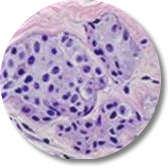|
After the specimen is processed and microscopic slides are prepared,
the pathologist proceeds to examine it. Important clues to the
diagnosis may have already been gleaned from careful examination of
the gross specimen. For example, a melanoma of the skin often
presents as a large black tumor when sections are taken through it.
But the final diagnosis always rests upon what is seen under the microscope. |
 |
The Pathologist initially determines:
|
At this low scanning power, areas on the tissue which require closer inspection are identified. By changing the ocular objectives by a simple rotation of the microscope head, a higher power magnification can be obtained. For most routine work, this is usually a range of 200-400x magnification. At these higher magnifications, the pathologist now confirms their initial impression or finds something that may lead them down another diagnostic pathway. At higher magnification, the following questions can now be answered. |

High Power Microscopic View Breast Cancer Cells |
Pathology, as you have probably surmised, is a very visual science. It appeals to people who have a talent for recognizing patterns. It is stated that a grand chess master has easily memorized the moves of over 300 games. For non-chess players, this feat may appear daunting. For a master, it is a simple matter. This pattern recognition comes after years of practice. The same is true for pathology.
Another way to rephrase the question is, What are you seeing on the microscope slide when others only see colors and cells?
We are looking for patterns. Cancers grow in recognizable patterns that allow for their identification. A melanoma has a certain growth pattern that differs from a carcinoma of the prostate. Benign conditions also have patterns. Skin rashes, for example, are diagnosed by a combination of the type of inflammatory cells and location in the skin, that is, whether the inflammation is around blood vessels, within the epidermis, or scattered. These basic principles are extrapolated to all tissues.
A pathologist will never make a diagnosis unless they are 200% sure of the diagnosis. Having said that, there are situations where a definitive diagnosis cannot be rendered. Sometimes it is because the biopsy sample that was taken by the surgeon is too small, or perhaps taken from an area that is not representative of the patient's lesion. Other times, the diagnostic process of key cells may be obscured by inflammation or the effects of treatment such as chemotherapy. Finally, there are times when a pathologist must admit that they do not know. Considering that the rarest of diseases pass under the pathologists' microscope, this is not surprising. There are several diagnostic tests or special stains which the pathologist can turn to which may aid in the diagnosis. However, if these tests are not helpful, the pathologist may turn to a consultant, a recognized expert in their field. The emergence of telepathology may also provide another source of immediate consultation for the pathologist.
CONSULTATIONS CHARACTERIZATION
Clinicians are from Mars and pathologists are from Venus.Powsner SM, Costa J, Homer RJ.
Department of Psychiatry and Center for Medical Informatics, Yale University School of Medicine, New Haven, Conn., USA.
Arch Pathol Lab Med 2000 Jul;124(7):1040-6 Abstract quote CONTEXT: Text reports convey critical medical information from pathologists, radiologists, and subspecialty consultants. These reports must be clear and comprehensible to avoid medical errors. Pathologists have paid much attention to report completeness but have ignored the corresponding issue of report comprehension. This situation presents an increasingly serious potential problem. As laboratories are consolidated and as reports are disseminated in new ways (eg, via the World Wide Web), the target audience becomes more diverse and less likely to have any contact with pathologists beyond the written reports themselves.
OBJECTIVE: To compare clinician comprehension with pathologist intent in written pathology reports.
METHODS: Typical surgical pathology reports relevant to surgeons and covering a range of specimen complexity were taken from our hospital files. Questionnaires based on these cases were administered open-book-examination style to surgical attending physicians and trainees during surgical conferences at an academic medical center.
MAIN OUTCOME MEASURES: Scores from questionnaires.
RESULTS: Surgeons misunderstood pathologists' reports 30% of the time. Surgical experience reduced but did not eliminate the problem. Streamlined report formatting exacerbated the problem.
CONCLUSIONS: A communication gap exists between pathologists and surgeons. Familiarity with report format and clinical experience help reduce this gap. Paradoxically, stylistic improvements to report formatting can interfere with comprehension and increase the number of misunderstandings. Further investigation is required to reduce the number of misunderstandings and, thus, medical errors.
Surgical pathology extradepartmental consultation practices.Azam M, Nakhleh RE.
Department of Pathology, North Ottawa Community Hospital, Grand Haven, Mich (Dr Azam), and the Department of Pathology, Henry Ford Hospital, Detroit, Mich (Dr Nakhleh).
Arch Pathol Lab Med 2002 Apr;126(4):405-12 Abstract quote Objectives.-To document the practice parameters and case characteristics associated with personal (expert) consultations. We also examine the value, level of participant (customer) satisfaction, turnaround time, and rate of personal consultations.
Design.-We asked participants in the College of American Pathologists' Q-Probes program to document cases sent for consultation during 4 months or up to 20 cases. They documented patient and specimen characteristics, the turnaround times, and the participants' levels of satisfaction with the consultation experience.
Participants.-One hundred eighty laboratories/surgical pathology practices. One hundred seventy-two (95.6%) were from the United States; the remainder were located in Canada and Australia.
Main Outcome Measures.-Rate and turnaround time of consultations and participant level of satisfaction. Results.-A total of 2746 consultation cases were examined for an aggregate consultation rate of 0.5% (median, 0.7%). Institutions with a higher occupied bed size and a greater number of surgical pathology cases both had lower consultation rates (P </=.05). The median turnaround time (defined as the interval from the date on which the case was sent to the date on which the diagnosis was received) was 6 days. Twenty-nine percent and 68% of cases had a turnaround time within 3 and 7 days, respectively. Fifty-two percent of cases were sent to nationally known experts, and 32% were sent to local experts. Skin (18.0%), hematolymphoid (11.6%), and breast (9.6%) specimens were most commonly sent for consultation. In 70.5% of cases, the consultant confirmed the referring pathologist's original diagnosis, but in 15.9% of cases, the consultant also added significant information. Satisfaction rates were higher with faster turnaround times and verbal reporting. Satisfaction rates were lower for cases in which the patient or the clinician requested the consultation and in which the consultant's diagnosis was ambiguous.
Conclusions.-This study establishes a multi-institutional consultation rate of 0.5%, defines the nature of surgical pathology consultations, and demonstrates that satisfaction with consultations is associated with a faster turnaround time and receipt of additional, clinically meaningful information.
Misinterpretation of normal cellular elements in fine-needle aspiration biopsy specimens.Young NA, Mody DR, Davey DD.
Department of Pathology, Fox Chase Cancer Center, Philadelphia, Pa (Dr Young); Department of Pathology, Baylor College of Medicine, Houston, Tex (Dr Mody); and Department of Pathology and Laboratory Medicine, University of Kentucky, Lexington, Ky.
Arch Pathol Lab Med 2002 Jun;126(6):670-5 Abstract quote Context.-The College of American Pathologists Interlaboratory Comparison Program in Non-Gynecologic Cytopathology is a popular educational program for nongynecologic cytology, with 1018 participating laboratories by the end of 2000. Data generated from this program allow tracking pathologist performance in a wide variety of laboratory practices.
Objective.-To review performance of participating pathologists in making patient diagnoses with fine-needle aspiration biopsy specimens, with particular interest in the false neoplastic diagnoses (both benign and malignant neoplasms) that were submitted for benign aspirates containing only normal cellular components.
Design.-We reviewed the diagnoses made from 1998 through 2000 by participating pathologists through the use of glass slides containing benign fine-needle aspiration biopsy specimens of the liver, kidney, pancreas, and salivary gland that contained only normal cellular components.
Results.-The false neoplastic rate for kidney (60%) was the highest, followed by liver (37%), pancreas (10%), and salivary gland (6%). These rates are much higher than what has previously been reported in the literature.
Conclusions.-This study illustrates that normal cellular elements are a significant pitfall for overinterpretation of fine-needle aspiration biopsy specimens.
Quantifying the Value of In-house Consultation in Surgical Pathology
Andrew A. Renshaw, MD
Nat E. Pinnar, MD
Michael R. Jiroutek, MS
Mary L. Young, MSAm J Clin Pathol 2002;117:751-754 Abstract quote
In-house consultation is a well-known method to improve diagnostic accuracy and agreement, but the technique has not been well studied. We reviewed the results of in-house consultation in a large private hospital practice setting for a 1-month period and determined its effect on diagnostic accuracy using the final sign-out as the "gold standard."
During this 1-month period, 352 cases were reviewed as in-house consultations. Initial complete agreement was found in 315 (89.5%) cases. Using the initial diagnosis as the test case and the final sign-out as the gold standard, of the 37 discrepant cases, 4 (1.1%) were thought to represent false-negative results, 1 (0.3%) a false-positive result, 3 (0.9%) differences in type, and 29 (8.2%) differences in diagnostic threshold.Disagreements in 10 cases were thought to be potentially clinically significant. Internal consultation was obtained on approximately 20% of all cases seen in the laboratory, and disagreements were found in 2% of all cases.
Internal consultation has a significant and measurable impact on the practice of surgical pathology.
Basic Principles of Disease
Learn the basic disease classifications of cancers, infections, and inflammation
Commonly Used Terms
This is a glossary of terms often found in a pathology report.Diagnostic Process
Learn how a pathologist makes a diagnosis using a microscopeSurgical Pathology Report
Examine an actual biopsy report to understand what each section meansSpecial Stains
Understand the tools the pathologist utilizes to aid in the diagnosisHow Accurate is My Report?
Pathologists actively oversee every area of the laboratory to ensure your report is accurate
Last Updated November 28, 2006
Send
mail to The Doctor's Doctor with
questions or comments about this web site.
Read the Medical Disclaimer.
Copyright © The Doctor's Doctor